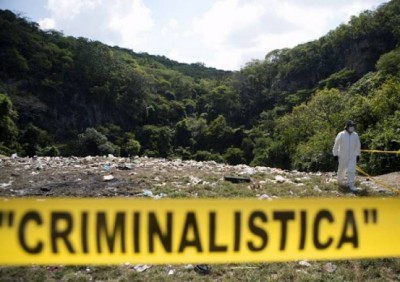Violence Intensifies in Mexico as Authorities Unearth 10 Headless Bodies

Mexican police have unearthed ten decapitated bodies and eleven heads in unmarked graves Tuesday near the city of Chilapa de Alvarez, 31 miles east of Guerrero state’s capital, Chilpancingo. The bodies were found spread throughout six clandestine graves with their hands tied and showing signs of torture. The heads of the victims were discovered in another grave inside four plastic bags.
Prosecutors have yet to identify the victims and are attempting to find the eleventh body and to ascertain if the heads belong to the corpses found in the graves. An anonymous-tip off alerted the police to the graves. The remains have been taken to the Forensic Medical Service of Chilpancingo for identification.
The brutal methods used against these victims are all too familiar. Last September, in the southern town of Iguala, Guerrero, 43 students were abducted by police and turned over to a drug gang, which is believed to have massacred them all. According to some reports, victims were burned alive. The disappearance of the students sparked protests across the country and internationally. Hundreds of thousands have taken to the streets, denouncing the Mexican government, calling for the resignation of President Enrique Peña Nieto and demanding that all those involved be held accountable.
The Mexican government is still investigating the fate of the 43 students, as more than 50 people, including police and public officials, have been arrested in connection with the atrocity. There is well-founded belief and evidence that the mayor of Iguala ordered local police to detain the students, who were subsequently handed over to members of the drug cartel, Guerreros Unidos. The remains of only one of the missing students have been positively identified.
News of violence occurring in the state of Guerrero is, unfortunately, becoming a monthly routine, as 11 more headless bodies were found in the area last November.
No one is immune from the violence. Three Roman Catholic priests were killed and found last year in Guerrero. Father Gregorio Lopez Gorostieta’s body was found on Christmas Day with a bullet in his head. Father John Senyondo was found in a clandestine grave in September and is believed to been killed by drug traffickers for his refusal to perform a wedding or baptism. Father Ascension Acuna Osorio was also found in September, floating in a river.
The church has been divided over the drug cartels, with sections of the hierarchy backing the government, even as some parishes accept donations from drug lords. Others – mostly lower ranking clerics – have condemned both the trafficking and the death toll inflicted in the government’s “war on drugs.”
According to statistics published by the Mexican Secretaria de Gobernacion (SEGOB), Guerrero was the most violent state in 2013, with 2,087 homicides and 207 reported cases of kidnapping. Kidnappings nationwide increased 20 percent from the previous year.
The level of violence is further spelled out by a survey conducted by the National Institute of Statistics and Geography that has estimated that there were 105,682 kidnappings in 2012 alone! Only 1,317, less than one percent of the victims, reported the abductions to police. There can be no misunderstanding that the high number of kidnappings and the unwillingness to report the crime can only occur with the full cooperation of local police and publicly elected officials.
These violent methods are not just a matter of a war on drugs, but grow inevitably out of a society characterized by an immense level of social inequality. While Mexico is home to the world’s second richest man, Carlos Slim, who built his fortunes through communications and various other enterprises and has a net worth of $72.6 billion, approximately half of the country’s population lives in poverty. The richest 10 percent of the population have an average income almost 30 times as high as the bottom 10 percent. Mexico is also the most unequal of the 34 member countries of the Organization for Economic Cooperation and Development (OECD).
In a press conference with President Peña Nieto last Tuesday, President Barack Obama reaffirmed his commitment to back the Mexican president in the continuing phony war on drugs: “Our commitment is to be a friend and supporter of Mexico in its efforts to eliminate the scourge of violence and drug cartels that are responsible for so many tragedies inside of Mexico and we want to be a good partner in that process.” For his part, Peña Nieto made no mention of the student massacre in Iguala, while Obama only made a passing reference.
Since the so-called drug war was launched in 2006 under Peña Nieto’s predecessor, President Felipe Calderón, an estimated 130,000 Mexicans have lost their lives, while, according to the government’s own figures, 22,322 “disappeared” and remain missing.
With the launching of the Merida Initiative in 2008, the US has supplied Mexico with some $2 billion in arms aid, while training security forces and sending “advisors” across the border. It is entirely plausible that much of the arms and aid sent to Mexico has landed in the pockets of the drug cartels.
Neither the US nor the Mexican government has any real interest in stopping the flow of drugs. Washington’s real concern is to ensure that the interests of the US transnationals that exploit Mexican labor and resources are protected at any cost. Workers, students and youth north of the Rio Grande should take the events in Guerrero as a serious warning; the same methods employed in Mexico will be employed against mass struggles at home.

